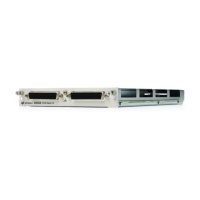22 Keysight 34950A User’s Guide
For example, the following SCPI commands set a 34950A in slot 5 to have an 8-bit
input using synchronous handshake with an external strobe input. The number of
bytes to read into memory is set to infinite (continuous reading into memory until
the memory is stopped). The memory is enabled and then triggered. The start/
stop line is set high following the first byte handshake and remains high until the
last byte is captured.
CONF:DIG:WIDT BYTE, (@5101)
CONF:DIG:DIR INP, (@5101)
CONF:DIG:HAND SYNC, (@5101)
SENS:DIG:MEM:SAMP:COUN 0, (@5101)
SENS:DIG:MEM:ENAB ON, (@5101)
SENS:DIG:MEM:STAR (@5101)
Synchronous Buffered Outputs
You can use synchronous mode handshake with buffered (memory) output
operations. (Buffered operations are described in more detail beginning on
page 25.) For buffered output operations, the H0 line acts as a start/stop line. This
line will be set high when the memory output command is executed by the
34950A and will return low when the memory output operation has completed.
Synchronous memory output operations can be paced using either the internal
strobe or an external strobe.
When using the internal strobe, the H1 line is the strobe output line. The timing of
the output operation when using the default INTernal clock is controlled by the
CONFigure:DIGital:HANDshake:RATE command. This setting affects strobe
width, memory clock rate, as well as the setup and hold times. Alternatively, the
reciprocal form of the command CONFigure:DIGital:HANDshake:CTIMe can
be used to specify the speed in terms of time instead of a rate. The timing should
H0 (Start/
Stop)
H2 (Strobe In)
Data In
Valid Don't-Care
T
SETUP
T
HOLD
T
CYCLE
>
100 ns
T
SETUP
T
HOLD
Valid
(Last Cycle)
Don't-Care Don't-Care Don't-CareValid
> 50 ns

